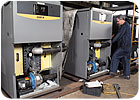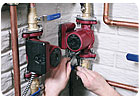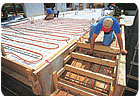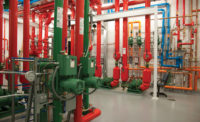
The newest generation of hydronic equipment-such as those with condensing technology that tenaciously extracts heat from condensate within the system-has pushed combustion efficiency into the 95%-99% range. That's smart use of energy and a key determinant in building a high-efficiency hydronic system. This high efficiency also becomes a very important part when long-term operational cost of the system is examined. When the design engineer can calculate a three- to four-year payback (or less) for new equipment, there's real incentive to install new technology.
So if the spec dictates high efficiency, as many do today, the next question may be: How high? Non-condensing commercial boiler technology offers a lot, with broad capabilities and fuel efficiency into the mid-to-high 80s percentile. If that's not enough, new condensing boilers can deliver up to 99% efficiency.
But as many of you know well, other facets influence the type of system that's best suited for the job. A key factor in the selection of a boiler has to do with anticipated temperature of the return water or glycol mix. If the temperatures are low (say, in the range of 60°F to 130°F), a condensing boiler will operate most efficiently. If return water/glycol mix temperatures are high-above 130°F-then non-condensing equipment may make more sense.
Along with the need to consider system temperature is the need to consider stage-fired or modulating units. These units supply less-than-full input when the full input of a boiler isn't needed. In many cases, a condensing boiler even gains efficiency when it's running at a lower firing rate. Multiple boilers can be another way to increase system efficiency, again allowing for lower input to the system when full input isn't needed.

The Condensing + Non-Con Twist
One of the more interesting approaches to commercial boiler system design is the deliberate joining of condensing and non-condensing boilers. Mixing condensing and "non-con"
System Efficiency: The Sum of Many Parts
Though the boiler(s) may be the most important single piece of a hydronic system, overall system efficiency depends on the interrelationship of several key parts, all of which are changing and evolving as new ideas and technology influence their role in the mix.

The Role of Hydronic Components
The performance of various hydronic components, and their interactions within the system, often plays a key role in determining overall hydronic system efficiency.
One of the newest developments to enter the hydronic realm, enhancing both system performance and efficiency, combines hydraulic separation and a distribution manifold into one compact device. One such unit accomplishes "adequately designed plumbing out of the box"

The Role of Circulation
One of the most important facets to optimal circulation for hydronic systems is for design engineers and installing contractors to match a pump's performance, or flow characteristics, to the specific job that it needs to perform within the system. And building owners want dependable performance and low energy consumption.Thanks to many recent advances in the arena of hydronic circulation, all of these needs can be accomplished manually or electronically. The latest advancements are responsive, intelligent and energy-wise electronic circulators featuring EFF1 motors, which are classified as the most efficient motor type, especially during partial-load operation-quite common within a pump system.
One line of integrated variable-speed drive circulators offers either constant temperature, flow and pressure control, or the optional capability of differential pressure with the use of a transducer to the pump suction and discharge flanges. This enables the choice of proportional differential pressure control with firmware that maps pump performance to maximize energy savings. An advantage is the unit's combination of pump, motor and variable-speed drive, which also reduces the space required in the mechanical room or at remote zone locations. The single-piece unit also offers plug-and-play operation, requiring only one electrical connection.
Unit pumps can be used in a variety of heating or chilled water systems, pressure boosting, domestic water recirculation and to pump liquids to radiantly heated or cooled surfaces. And, energy savings due to variable-speed circulation (as opposed to constant speed) offers proven short payback time with life-cycle cost analysis.
Ultimately, the efficiency equation all comes back to the sum of many parts. If the system's many components are designed to work in concert with one another, the high-efficiency grail can be achieved.
